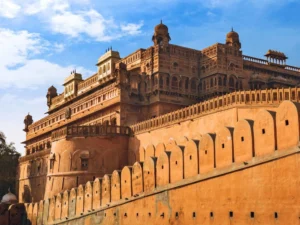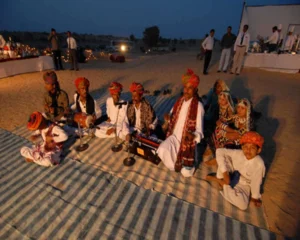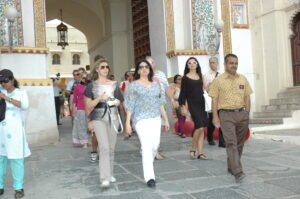
Junagarh Fort is a famous landmark in Bikaner, known for its stunning architecture and rich history. Inside the fort, you’ll find a collection of palaces, temples, and museums, including Karan Mahal, Anup Mahal, Phool Mahal, Chandra Mahal, and various havelis. Originally named ‘Chintamani Durg,’ the fort was renamed ‘Old Fort’ in the early 20th century after the royal family moved to Lalgarh Palace. Today, it stands as one of the top attractions in Bikaner, drawing visitors for its beauty and historical charm.
History
Bikaner and its forts have a rich and extensive history. These forts weren’t just architectural marvels; they played vital roles in protecting the city from invaders, serving as royal residences, and functioning as administrative hubs. Their importance in shaping the history of the region is undeniable. Here’s a quick overview of the history of Bikaner and Junagarh Fort that you should know.
History of Bikaner:
Bikaner was founded by Rao Bika, the second son of Rao Jodha, the ruler of Jodhpur (formerly known as Marwar). Knowing he wouldn’t inherit the throne, Rao Bika set out to establish his own kingdom, which he named Jungladesh. His first construction was a modest stone fort, and over time, more structures were added, gradually shaping the region. This area came to be known as Bikaner, meaning the settlement of Bika. Although rulers changed over the years, the name Bikaner endured through generations.
History of Junagarh Fort:
About 100 years later, Raja Rai Singh became the sixth ruler of Bikaner. During the Mughal era, he accepted the authority of the Mughals and served as an army general under both Emperor Akbar and Emperor Jahangir. His service and loyalty earned him significant rewards, which he used to construct a new fort outside the original stone fort built by Rao Bika. This new fort, called Chintamani Durg, became the most important fort in Bikaner. Construction of the fort began on flat land in 1589 and was completed in 1594. In the early 20th century, it was renamed Junagarh Fort, meaning Old Fort. One remarkable fact about Junagarh Fort is that, despite being built at ground level, it was never conquered by enemy forces.
Architecture
Junagarh Fort in Bikaner showcases a unique blend of Rajput, Gujarati, and Mughal architectural styles. The fort is constructed using red sandstone sourced from Jodhpur, featuring intricate carvings in red and gold sandstone that make it stand out. Covering an area of 5.28 hectares, the fort houses a variety of temples, palaces, and other structures. Its defensive wall stretches 986 meters and is reinforced by 37 bastions. Originally, Junagarh Fort was encircled by a protective moat, which no longer exists today.
Must-See Attractions at Junagarh Fort, Bikaner
Junagarh Fort is filled with impressive structures, including palaces, temples, gates, and museums that attract many visitors. Here are some must-see spots when exploring Junagarh Fort:
Gates
Junagarh Fort, also known as Bikaner ka Kila, has seven gates, but only two serve as the main entrances: Karan Pol and Suraj Pol. In the past, Karan Pol was the primary entry and exit point, while Suraj Pol now serves as the main gate. Suraj Pol is particularly striking, built from yellow sandstone that glows beautifully in the morning sunlight. The gate is further enhanced by two red sandstone elephant statues that add to its grandeur.
Palaces
A fort wouldn’t be complete without its grand, royal palaces, and Junagarh Fort in Bikaner is no exception. Over the years, various rulers added to the fort’s splendor by building and expanding these palaces. Here are some of the most notable palaces within Junagarh Fort:
- Karan Mahal – Built in 1680 by Emperor Karan Singh to celebrate his victory over Mughal Emperor Aurangzeb, Karan Mahal is one of the most magnificent palaces in Junagarh Fort. It is known for its opulent design, featuring lush gardens, elegant stained glass windows, and intricately crafted balconies. Constructed using red and gold sandstone, Karan Mahal radiates grandeur and luxury, making it a standout in the fort’s collection of royal structures.
- Chandra Mahal – Chandra Mahal is considered the most regal palace within Junagarh Fort. Its walls are adorned with intricately cut mirrors and stones that create a mesmerizing visual experience. One of the unique features of this palace is found in the royal bedroom, where mirrors are strategically positioned so that the king could observe anyone entering the room without leaving the comfort of his bed. This clever design showcases both the luxury and the thoughtful detail that went into its construction.
- Anup Mahal – Anup Mahal was the administrative center of the kingdom and is renowned for its luxurious design. The palace features intricately carved wooden ceilings adorned with mirrors, elegant Italian tiles, and artfully designed lattice windows and balconies. With its rich blend of artistry and detail, Anup Mahal stands out as one of the most opulent palaces in Junagarh Fort.
- Badal Mahal – Badal Mahal is an extension of Anup Mahal, distinguished by its impressive collection of paintings. The walls of this palace are adorned with vivid artwork depicting various scenes, including the Shekhawati Dundlod chiefs paying homage to the king, people performing feats by standing on nails, wood, swords, and saws, as well as depictions of the divine duo Krishna and Radha. These paintings add a unique cultural and historical richness to the palace, making it a captivating part of Junagarh Fort.
Phool Mahal – Also known as the Flower Palace, Phool Mahal is the oldest section of Junagarh Fort. It showcases the Mughal architectural style, with intricate floral patterns embellishing its walls and ceilings. This palace reflects the delicate artistry and attention to detail typical of Mughal design, making it an essential part of the fort’s rich history.
Temples
Junagarh Fort in Bikaner also houses temples dedicated to various deities, reflecting its religious and cultural significance. The Har Narayan Temple is dedicated to Lord Lakshmi Narayan and Goddess Lakshmi and served as the private temple for the royal family. Another notable temple near the fort is the Ratan Behari Temple, devoted to Lord Krishna. This temple is built in the Indo-Mughal architectural style and features elegant white marble, showcasing a blend of intricate craftsmanship and spiritual reverence.
Museum
Within Junagarh Fort, there is a museum that captivates visitors with its rich collection of historical artifacts. Established by Dr. Karni Singhji in 1961, the museum showcases an array of paintings, jewels, and other items that reflect the lifestyle of the kings who once ruled and resided in Bikaner. Among its treasured displays are Sanskrit and Persian manuscripts, royal costumes, farmans (royal decrees), ceremonial dresses for deity idols, palanquins, and more. The museum is also notable for its impressive collection of post-medieval weaponry, adding to its appeal for those interested in the region’s rich history and royal heritage.
Best Time to Visit
The ideal time to visit any destination is when the weather is pleasant and comfortable for exploring. Since Junagarh Fort in Bikaner is situated in the middle of the Thar Desert, summers can be extremely hot. To make the most of your visit, it’s best to plan your trip during the cooler months from November to February.
Junagarh Fort is a perfect spot for a day outing in Bikaner and is a key highlight in most Bikaner tour packages due to its historical significance and charm. When visiting, be sure to carry water, wear comfortable shoes, and apply sunscreen, as exploring the fort requires plenty of walking.
How to Reach Junagarh Fort, Bikaner in a Luxurious Manner
For luxury travelers seeking an exceptional experience at Junagarh Fort, Bikaner, the Maharaja Express luxury train offers an unparalleled journey. Renowned for its opulent ambiance, personalized service, and regal charm, the train provides a seamless blend of comfort and heritage as it travels through Rajasthan’s iconic destinations. Arriving at Junagarh Fort in the grandeur of this luxury train elevates your visit, offering curated excursions, exclusive guided tours, and insights into the fort’s rich history. With exquisite on-board dining, lavish suites, and exceptional amenities, the Maharaja Express ensures your exploration of Bikaner’s architectural marvel is both memorable and indulgent.
 Toll-Free 1-855-952-6526
Toll-Free 1-855-952-6526 +44 1753 201 201
+44 1753 201 201  61-2-86078986
61-2-86078986  + 44 ( 0 ) 7739 716978
+ 44 ( 0 ) 7739 716978 










